Silviculture
Katha extraction
Agri-silviculture
Plantation crop combination
Large cardamom based agroforestry system
Bamboo groves as a component of agriculture holdings (Agri-silviculture)
Multipurpose trees on the crop land
Private and community fodder wood blocks
Seabuckthorn: Potential resource
Wood lots
i) Sacred wood lots: It is an old traditional practice to conserve and protect an entire forest or a small wood lot in the name of the village Deity (Kul Daveta). This is prevalent in every village of the mountainous region of India, particularly so in Himachal Pradesh, Garhwal and Kumaon hills and also Kashmir hills. A temple along with a hut or shelter is constructed to keep the items/utensils of the village Diety. All religious rites are performed in its complex and no body is allowed to fell the trees. This is also a common practice in the hills of Kangra, Mandi and Shimla districts. It is also seen that a perennial water source is managed either in the forest or near it, for common use by the village for drinking purpose.
ii) Private and community wood lots: Community and private forests (wood lots) are protected at the community level. In community forests, the whole area is divided into small block or compartments and each compartment is allotted to the inhabitants for rotational lopping of fodder particularly oaks woodlots during lean (winter) season. Frequent fuel wood collection is permitted only in case of twigs and/or branches which are carried and stocked in a traditional manner (Fig. 3.1a, b & c).
Fig. 3.1a Fire wood collection
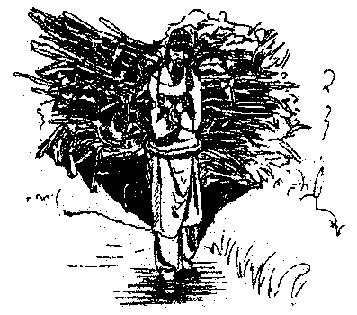
Fig. 3.1b Fire wood collection
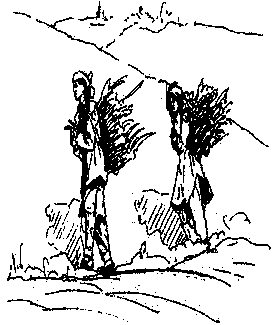
Villagers employ or engage a caretaker for the protection of private or community forests. No one is allowed to lop and cut trees for fuel wood. If some one is found doing so, the caretaker confiscates his/her sickle/axe and ask him to appear before the village panchayat, which imposes a penalty on him in the form of monetary fine or otherwise. Every household in the village contributes some grain or cash in each crop season for the caretaker's maintenance. In water logged areas along with kuhal or nallas people raise plantations of Salix (Bhains), Alnus (Kunish) or other moisture loving trees. Farmers make extensive use of the wood from both private and community forests for building all kinds of houses, shelters etc. (Fig. 3.2a, b & c) and have devised their own technologies for postharvest processing of the wood (Fig. 3.2d & e).
Fig. 3.1c Stocking of fire wood
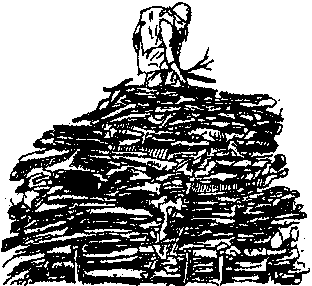
Fig 3.2a Traditional roofing made of wood and slates
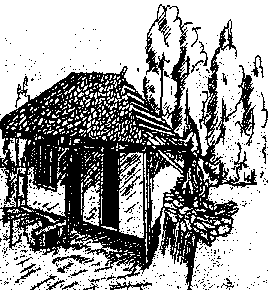
Fig 3.2b Mountain wooden house
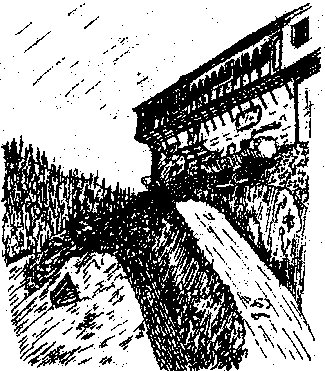
Fig. 3.2c Traditional mountain wood house
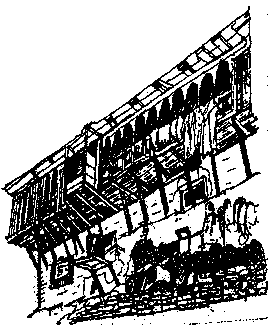
The heart wood chips of Acacia catechu trees are boiled in earthen pots along with water for about 12 hours or till the boiling mixture attains a thick syrup like consistency (Fig. 3.3a). This thick liquid is poured into moulds dugout in fine sand which absorbs the tannic acid (liquid) and leaves behind a residue of catchin (Katha) in a crystallized form (Fig. 3.3b). On cooling it solidifies and then is cut into small bricks for sale in the market under the trade name of 'katha'. In India it is consumed with beetle leaves and used medicinally for intestinal disorders and is known to improve digestion.
Fig. 3.2d Timber sawing

Fig. 3.2e Timber saw

Fig. 3.3a Katha extraction process
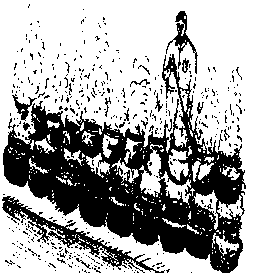
Fig. 3.3b Katha extraction process

Traditional minor forest resources management
In the lower hills of Himachal Pradesh, Uttar Pradesh and of Jammu & Kashmir, Acacia catechu (Khair) for katha, Pinus roxburghii (chirpine) for resin. Acacia nilotica (Kikar) for tannin and gums and Grewia optiva (Beul) for fodder and fibre are well known. The villagers manage and protect these trees/wood lots and obtain high economic returns. These wood lots are inaccessible for fuel and timber requirements. The villagers also get seasonal employment in these forests for the collection of value added minor forest products. Similarly in the Kinnaur district of Himachal state, which is known for the production of Pinus gerardiana (chilgoza) seeds and Prunus armenica (chuli) fruits, the local people have right to collect the same from the forest and to sell them in the market for economic remuneration. The Government forests of these species are managed by the villagers as common properties. These forests are divided into small blocks and each block is allowed to a family for protection, management and collection of produce.
Jhuming or shifting cultivation
It is a widely practiced farming system in the hills of north-east India, locally known as "podu" cultivation. It is believed that this farming system originated in the Neolithic period around 7000 BC.
This system involves cultivation of crops on steep slopes. Land is cleared by cutting forests, bushes etc. upto stump level in December-January, leaving the cut material for drying and then finally burning it to make the land ready for dibbling of seeds of different crops before the onset of rains (Fig. 3.4). The cultivation is confined to the village boundary and the total area brought under cultivation depends upon the family size. After 2-3 years, the area is abandoned for regrowth and a new site is selected to repeat the process.
Shifting cultivation was good at the time when it emerged, because mixed cropping on slopes under rainfed conditions and a dependence on local natural resources only kept disturbance of the soil to a minimum and furthermore its fertility was allowed to replenish adequately. But now, due to increase in both the population and the effective area under this farming system, it is considered to be hazardous because it is leading to resource degradation and ecological imbalance due to deforestation, increase of soil erosion and silting of reservoirs which further lead to floods. It is also a low technology and high labour intensive system.
Fig. 3.4 Forest burning for shifting cultivation
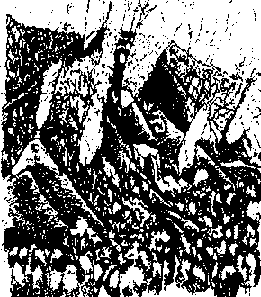
Various research institutes of ICAR, GOI and State Government working in the north-eastern part are recommending at scientifically tempered Agro-horti-silvi pastoral system as an alternative to shifting cultivation. Despite its adverse effects on the eco-system and low productivity it still persists because it is an integral part of the socio-cultural fabric of tribal life in the northeast and is clearly linked with their religious rites and festivals e.g. Agalmaka, Miamua, Rongchugala and Ahia of Garo Hills.
Homestead agroforestry system
A homestead or homegarden is an operational farm unit in which a number of tree species are raised along with livestock, poultry and/or fish; mainly for the purpose of satisfying the farmers' basic needs. This farming is traditional in the Himalayan region. In a home garden multiple crops are present in a multi-tier canopy configuration. The leaf canopies of the components are arranged in such a way that they occupy different vertical layers with the tallest components having foliage tolerant to strong light and high evaporation demand and the shorter components having foliage requiring or tolerating shade and high humidity.
In Hamirpur and Kangra districts of Himachal Pradesh the homestead is constituted of Fodder trees i.e. Celtis australis (Khirak), Bahaunia variegata (Kachnar), Grewia optiva (Beul) in the upper story. The middle storey is constituted of bushes like Adatoda vasica, Vitex negundo, lemon and Galgal as fruit trees. During the rainy season cucurbits (vines) are grown along with Colocacia, turmeric in the field and (winter) vegetables during the winter season.
In Meghalayan homestead pisciculture is the common practice. Fishes are generally reared in a dugout ponds either in a comer or in the centre of the home garden, so that run off can be collected in it. In the low lying or plain parts paddy is generally grown. Important timber trees are Pinus kesia (Khasipine) Alnus nepalensis (Utis) Schima wallichii (chillowane) etc. are grown in the homestead for their requirement. In the lower storey guava, banana and vegetables are grown for domestic consumption. As per the study conducted by the ICAR Research Complex for NEH Region, Shillong; in a dugout pond of 32m × 15 m 2.2 m size there was a production of 250 kg fishes in one season during the year 1990.
However, wide variations in the intensity of tree cropping are found among homegardens in different locations. This can generally be attributed to the differences in socio-economic conditions of the households and their responses to externally determined changes particularly to price of the inputs and products, dependence on land and tenurial conditions among others.
Plantation crops play a major role in national economics because they generate value added goods for the international market. The important plantation crops of the Himalayan region is tea. Traditionally, tea is grown on waste and marginal lands either in monoculture or in association with indigenous forest tree species. In Himachal Pradesh tea gardens in Kangra Valley are managed under the canopy of Albizia chinensis spp. which not only nurse the tea plants by fixing the atmospheric nitrogen in its roots but also provides shade for the development and maintenance of new tenders. The leaf litters of Albizia trees also add nutrients to the soil. Similarly in Assam and West Bengal the tree gardens are managed under Alnus nepalensis (Utis).
Large cardamom (Amomum subulatum) a traditional plantation crop is grown in an old typical agroforestry system. It is adapted to humid and shady environment and requires moist soil with good organic content. In natural forests it is raised in association with Alnus nepalensis (Utis), a shade tree adjoining to small perennial streams (Thoras). This helps to spread water seepage through the soil during most part of the year. Alnus nepalensis, fast growing tree, not only produces fuel wood and timber but also fixes atmosphere nitrogen and enriches the soil by adding litter which in turn benefits the large cardamom. It also serves as a catch crop; attracting leaf feeding insect-pests to itself thereby protecting the large cardamom crop. This silvi-horticultural system is very successfully practiced in Sikkim since over a century. The area reported under large cardamom is about 14, 000 ha in Sikkim and the acreage is expected to increase phenomenally with the aid and assistance of the Cardamom Board established in Sikkim recently. In Joginder Nagar, distt. Mandi (HP), cultivation of large cardamom is picking up under Celtis australis, Ficus spp., Alnus spp. etc. near the perennial streams or nalahs.
In Sikkim agriculture is well established as compared to other northeastern hill states. The farmer in Sikkim, by and large, adopts a mixed farming system. In all agricultural holdings along the streams and irrigation/drainage channels cultivation of bamboo (Dendrocalamus hamiltonii and D. sikkimensis is common place (Fig. 3.5a). Bamboo's are extensively used in building small farm houses, goat sheds, piggery enclosures, small baskets and string making (Fig. 3.5b). Large bamboo pipes are used as water conveyers in the farm irrigation/drainage system. Bamboo leaves serve as an excellent winter fodder for goat. Bamboo stumps/culms also protect the water channel from erosion. This system is limited only to he high rainfall areas or where the sufficient water is available to grow bamboo. A similar practice is also found in the Palampur area of Himachal Pradesh as well as in other northeastern states.
Fig. 3.5a Bamboo groves
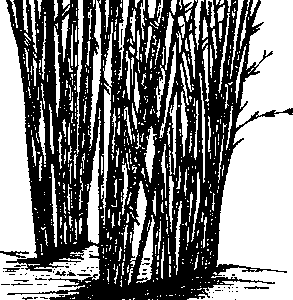
Fig. 3.5b Bamboo house roof

It is a common practice in the western Himalayan region to cultivate wheat, peas, potato, cauliflower, mustard etc. during winter and maize, tomato, chillies etc. during the summer season either in monoculture or mixed on the permanent terraces prepared across the hill slopes. Fodder, fuel and timber trees viz. Grewia optiva (buel), Celtis australis (Khirak), Bauhinia variegata (Kachnar), Albizzia chinensis (Ohi), Toona ciliata (Toon), Morus alba (Toot), Ulmus laviegata (meryano), etc. are deliberately left or grown on the bunds of terraces. This type of practice i.e. agrisivicultural system is prevalent in sub-montane and mid hills sub-humid zone of Himachal Pradesh (Fig. 3.6).
Fig. 3.6 Agroforestry: combination of trees and crops
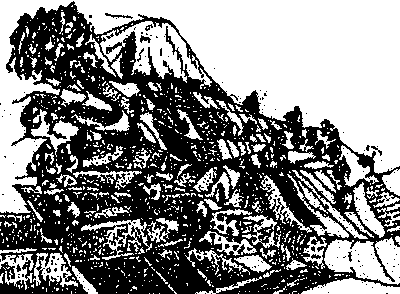
Similarly in the Agri-horticultural system which is predominantly followed in the mid hill-sub humid and high hill-temperate wet zones fruit trees are grown on terrace bunds along with agriculture crops since fuel and fodder are readily available from other sources. Agricultural crops like peas, cabbage, colocacia, turmeric and pulses are generally grown in the inter-spaces of horticultural trees such as Malus domestica (apple) Prunus domestica (plum), P. armeniaca (apricot) P. persica (peach), P. deueis (almond) and Pyrus communis (pear) Fig. 3.7. Tree are uniformly spaced in the field and average density of trees is generally 5 per 100 m2. In some cases fuel or fodder/timber trees are also retained on the field bunds and managed under agri-horti-silvicultural system. Besides providing fruits/fuelwood/fodder trees grown along bunds also restrict/.check erosion.
Fig. 3.7 Relay farming in which multi-purpose trees are grown in combination with food crops
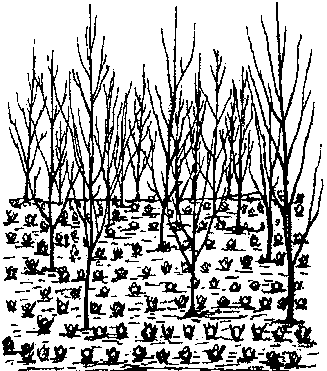
Fodder tree forests in the vicinity of villages, be they on forest land, community land or private land are jointly managed by the managers to meet their fodder need for cattle during lean period i.e. winter season. In the mid and high hills of Himalayas Quercus spps. (Oaks) forests are jointly managed and protected for the same whereas in the foot hills or sub-mountainous region other broad leaved trees i.e. Grewia optiva (Buel), Celtis australis (Khirak), Bauhinia variegata (Kachnar), Albizia chinensis (Oei) etc. are managed so as to meet fodder and fuel requirements (Fig. 3.8).
Fig. 3.8 Lopped and unlopped tree for fodder and fuel

Seabuckthorn (Hippophae L.) an ecologically viable and ethnobotanically sustainable food crop, belonging to family Elaegnaceae, is one of the few potential resources of high mountain areas which has been reported to offer hope to give multiple benefits to poor mountain man (Fig. 3.9a, b & c).
Seabuckthorn, (an indigenous plant which has survived under harsh climatic conditions such as average rainfall 350-1200 mm, average temperature in the range of 10-15°C and sometimes going below -40° to -50°C), is one such specie which has immense potential for satisfying all requirements. Seabuckthorn is widely distributed along high hills, river beds, valleys and along dry mountain slopes of this region both as healthy dense stands as well as in scattered gregarious dense patches in an altitudinal range of 700 in to as high as 5500 m and above.
Fig. 3.9a Seabuckthorn forest
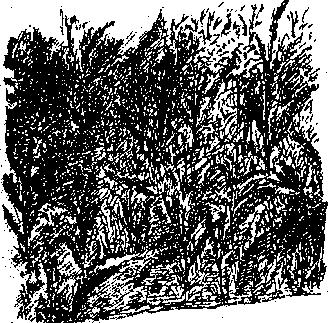
Fig. 3.9b Seabuckthorn fruits
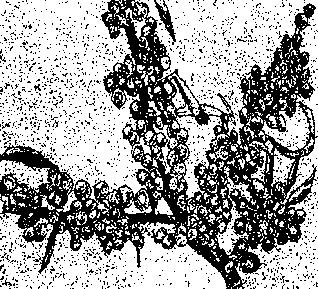
The people in high mountainous areas have been using seabuckthorn fruits for curing several ailments, including skin tumor diseases, digestive disorders and respiratory ailments, foot and mouth disease in cattle, besides using it extensively in agroforestry practices, though the farming community did not know of its exact potential. Seabuckthorn has also been a major source of fuelwood to local inhabitants who face scarcity of other sources of energy. Major traditional uses of Seabuckthorn in high mountainous cold and dry zone of Himachal Pradesh are fuelwood, fodder for goats and cattle (nutritious forage), fencing to protect fruit trees/nurseries/orchards, maintenance of traditional irrigation channel besides soil conservation, improving fertility/quality timber, useful for newly opened areas and subsidiary food items, medicinal products and alcoholic preparations.
Fig. 3.9c Nitrogen fixing nodules of seabuckthorn
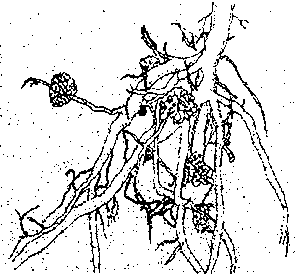
In Himachal Pradesh major gene pool areas have been identified at Spiti valley, Lahaul and Kinnaur, for 4 species and 9 subspecies of genus Hippophae reported from different parts of the world.
The introduction, promotion and development of seabuckthorn in this area seems meaningful and will not only help in vegetation rehabilitation, but also in ecological sustenance and economic gains to local farmers of the cold and dry mountain area.